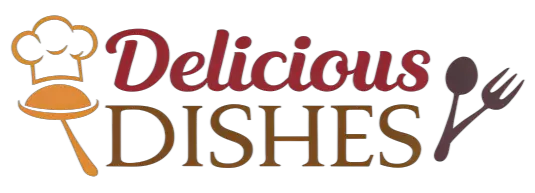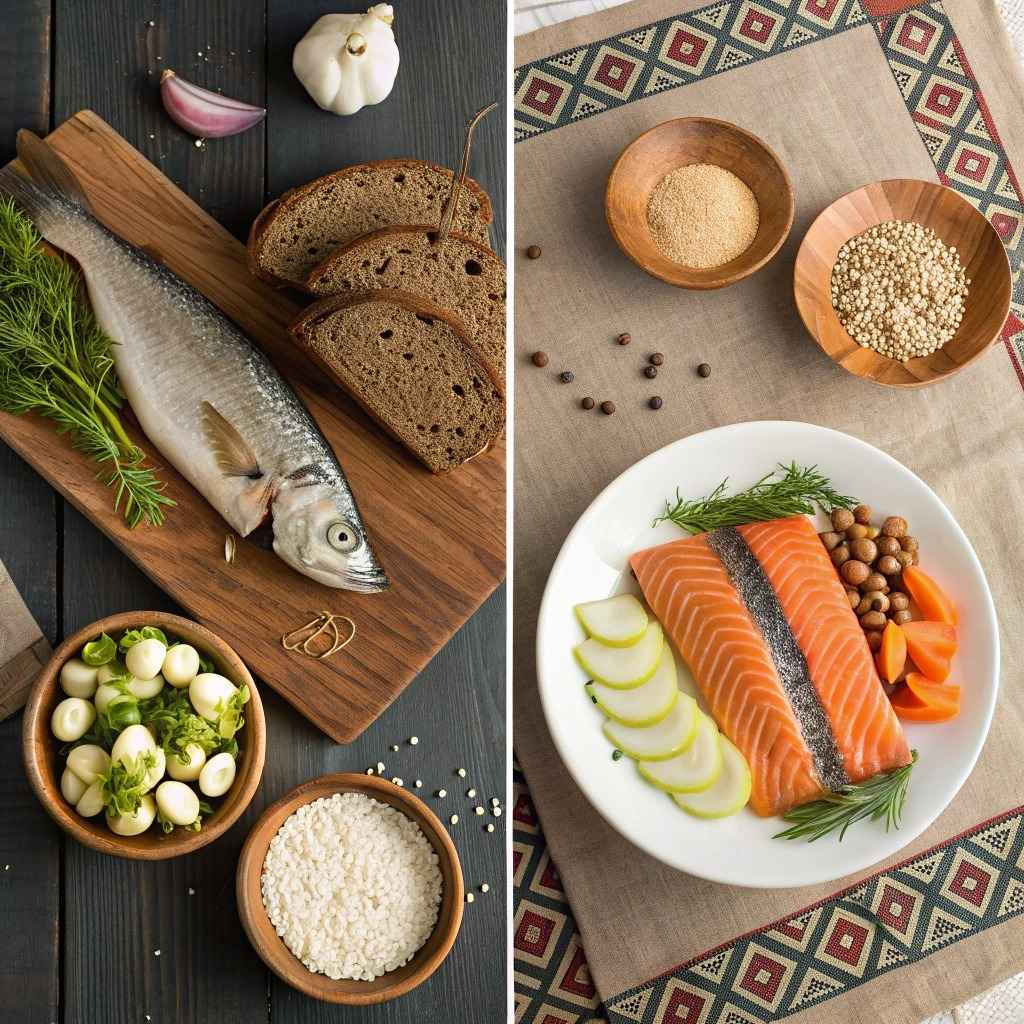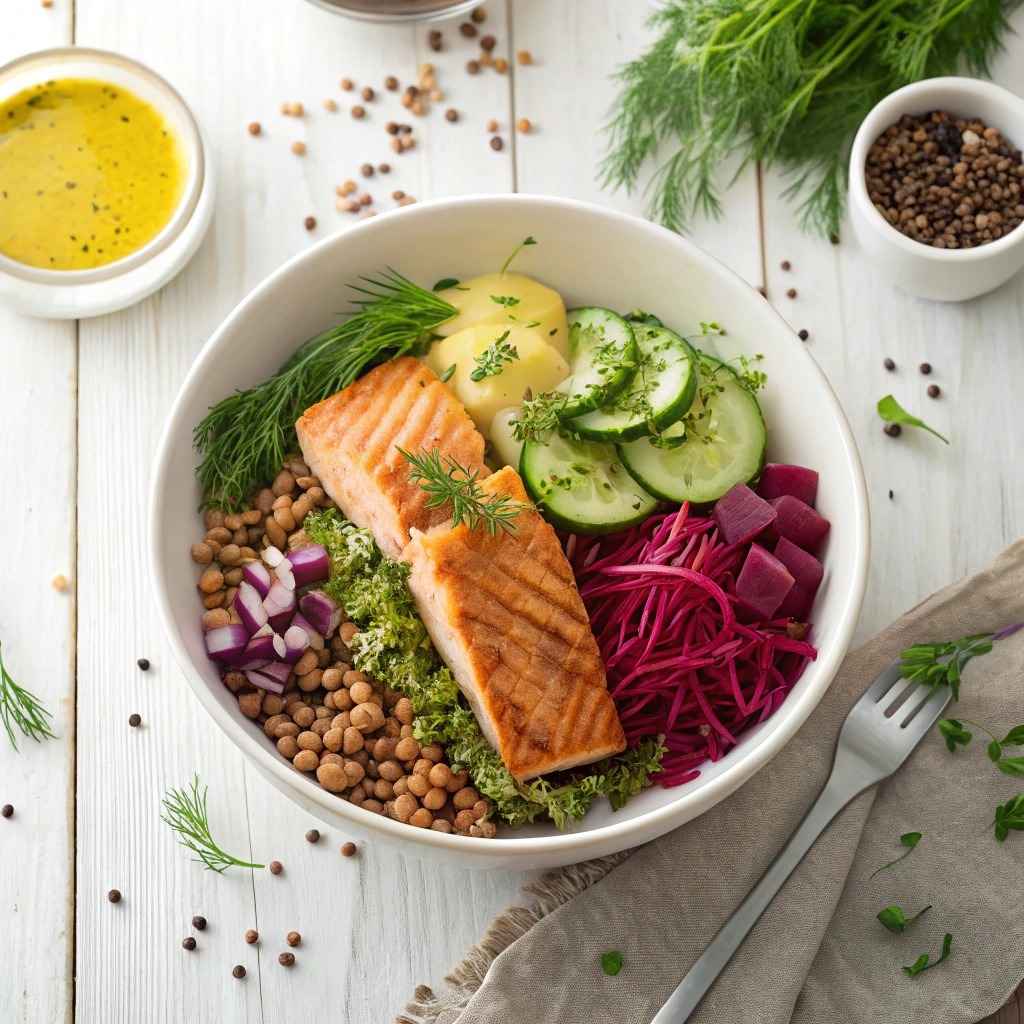Ancient Warriors, Modern Wellness?
The latest diet trend sweeping social media isn’t from a celebrity trainer or wellness influencer – it’s from 8th-century Norse warriors. The Viking diet, also known as the Nordic diet, is experiencing a remarkable renaissance as people seek alternatives to processed foods and embrace ancestral eating patterns. But before you start raiding your local fish market and stocking up on rye bread, let’s examine whether this ancient approach to nutrition deserves a place in your modern meal plan.
As a registered dietitian who’s analyzed countless viral food trends, I’ve learned to approach historical diets with both curiosity and caution. While the Viking diet does offer some compelling nutritional principles, the reality is more nuanced than the headlines suggest. In this comprehensive guide, I’ll break down what Vikings actually ate, examine the science behind the claimed benefits, address potential concerns, and show you how to incorporate the healthiest aspects of Nordic eating into your life – without the downsides.
Ready to separate the nutritional facts from the Viking fiction? Let’s set sail.
What Did Vikings Actually Eat?
To understand the modern Viking diet trend, we need to travel back to 8th-11th century Scandinavia, where Norse people developed eating patterns based on survival, seasonality, and available resources. Registered dietitian Lauren Harris-Pincus notes that “Vikings were limited to the foods available to them at the time” and “their diet focused on clean, sustainable foods, which is why we are discussing its health benefits today.”
The Traditional Viking Food Pyramid
Seafood: The cornerstone of Viking nutrition included salmon, herring, mackerel, cod, and other cold-water fish rich in omega-3 fatty acids. They also consumed whale and seal meat, though these are neither practical nor sustainable today.
Grains: Hardy whole grains like rye, barley, oats, millet, and buckwheat formed the base of many meals. These fiber-rich carbohydrates provided sustained energy for long voyages and harsh winters.
Vegetables: Root vegetables dominated their plant intake – onions, garlic, leeks, cabbage, carrots, turnips, and parsnips. These storage-friendly options could survive long Nordic winters.
Meat: Vikings consumed beef, pork, lamb, duck, and chicken, often preserved through smoking, salting, or drying. The high fat content was essential for surviving brutal winters.
Dairy: Milk, butter, and various cheeses provided additional protein and fats, while also serving as preservation methods for excess milk.
Nuts and Fruits: Walnuts, hazelnuts, raspberries, bilberries, plums, and wild apples added variety and nutrients when seasonally available.
Why the Viking Diet Is Trending Now
The modern appeal of the Viking diet stems from its emphasis on whole, unprocessed foods – a stark contrast to today’s ultra-processed food landscape. Harris-Pincus explains that it’s “similar to the Mediterranean diet… it’s based on whole foods.” With Americans consuming over 60% of their calories from processed foods according to recent studies, the Viking diet’s focus on natural ingredients resonates with health-conscious consumers seeking simpler eating patterns.
The diet also appeals to those interested in sustainable eating practices, as it emphasizes local, seasonal foods and minimal food waste – principles that align with modern environmental concerns.
The Science-Based Benefits of Nordic Eating
Research on traditional Nordic dietary patterns reveals several compelling health advantages that explain the current enthusiasm for Viking-inspired eating.
Cardiovascular Health Benefits
The high consumption of cold-water fish in the Viking diet provides exceptional levels of omega-3 fatty acids, particularly EPA and DHA. A 2019 study published in the Journal of Internal Medicine found that people following Nordic dietary patterns had significantly lower rates of cardiovascular disease and improved lipid profiles compared to those eating typical Western diets.
The fiber-rich whole grains that formed the foundation of Viking meals – rye, barley, and oats – contain beta-glucan, a soluble fiber that helps reduce LDL cholesterol levels. Research from the American Journal of Clinical Nutrition demonstrates that consuming 3 grams of beta-glucan daily can lower cholesterol by 5-10%.
Blood Sugar Regulation
Unlike refined grains common in modern diets, traditional Nordic grains have lower glycemic indices and higher fiber content. A comprehensive study in the British Journal of Nutrition found that people following Nordic dietary patterns had better insulin sensitivity and more stable blood glucose levels throughout the day.
The combination of protein from fish and dairy, healthy fats, and complex carbohydrates creates meals that promote steady energy levels rather than the blood sugar spikes and crashes associated with processed foods.
Anti-Inflammatory Effects
The Viking diet naturally includes numerous anti-inflammatory compounds. Cold-water fish provide omega-3s that actively reduce inflammation markers, while berries and vegetables contribute antioxidants like anthocyanins and flavonoids. A 2020 study in Nutrients journal found that people following traditional Nordic eating patterns had significantly lower levels of C-reactive protein and other inflammatory markers.
Gut Health Support
The high fiber content from vegetables, whole grains, and seasonal fruits supports diverse gut microbiome health. Traditional Nordic foods often included naturally fermented items like pickled vegetables and cultured dairy products, which provide beneficial probiotics. Research shows that diets rich in varied fiber sources promote the growth of beneficial bacteria linked to improved immune function and mental health.
Environmental Sustainability
From a sustainability perspective, the Viking diet emphasizes local, seasonal eating and minimal food waste – practices that significantly reduce environmental impact compared to modern food systems that rely heavily on long-distance transportation and packaging.
The Concerning Downsides of the Viking Diet
While the Viking diet offers legitimate nutritional benefits, attempting to replicate it exactly in our modern context presents several significant health concerns that any responsible nutritionist must address.
Excessive Saturated Fat Intake
Harris-Pincus warns that “this diet contains a significant amount of meat and animal fat compared to the Mediterranean diet.” Vikings consumed large quantities of fatty meats, full-fat dairy, and preserved animal products to survive harsh winters and physically demanding lifestyles. However, our sedentary modern lives don’t require the same caloric density.
Research consistently shows that diets high in saturated fat can increase LDL cholesterol and cardiovascular disease risk. While some saturated fat is necessary for hormone production and vitamin absorption, the Viking diet’s meat-heavy approach could provide 15-20% of calories from saturated fat – well above the American Heart Association’s recommended 6% limit.
Dangerously High Sodium Levels
Food preservation in Viking times relied heavily on salt, smoke, and fermentation, resulting in extremely high sodium intakes. “The preserved nature of Viking-era food also meant high sodium,” notes Harris-Pincus, which “is another heart health concern.”
Modern research links excessive sodium intake to hypertension, stroke, and kidney disease. The average American already consumes 3,400mg of sodium daily – far above the recommended 2,300mg limit. Adding traditional Viking preservation methods could easily push intake to dangerous levels.
Alcohol-Related Health Risks
Vikings consumed significant amounts of beer and mead (honey wine) partly because clean water was often unavailable. “Beer and mead were also common, sometimes even consumed by children due to lack of clean water,” historical records show. However, Harris-Pincus points out that “the beer-heavy lifestyle doesn’t align with healthy lifestyles” today.
Regular alcohol consumption is linked to increased cancer risk, liver disease, and numerous other health problems. The World Health Organization states that no level of alcohol consumption is completely safe for health.
Nutritional Imbalances for Modern Lifestyles
The Viking diet was designed for people engaged in intense physical labor in harsh climates. Their caloric needs often exceeded 3,000-4,000 calories daily, with much higher protein and fat requirements than modern sedentary or lightly active individuals need.
Following the traditional Viking macronutrient ratios could easily lead to weight gain and metabolic dysfunction in people with modern activity levels. Additionally, the limited variety of fruits and vegetables available in medieval Scandinavia means strict adherence could result in deficiencies in vitamins C, folate, and various phytonutrients abundant in modern produce.
Sustainability and Ethical Concerns
Traditional Viking diets included whale and seal meat – practices that are neither environmentally sustainable nor ethically acceptable today. Even the emphasis on large quantities of fish could contribute to overfishing if widely adopted without consideration for modern aquaculture limitations.
Expert Analysis: Adapting Viking Principles for Modern Health
Rather than attempting to replicate the Viking diet exactly, nutrition experts recommend extracting the beneficial principles while avoiding the problematic aspects. Harris-Pincus emphasizes that “it’s not important, wise or practical to follow the Viking diet exactly in our current food environment.”
What Modern Research Shows
A 2018 systematic review in Food & Nutrition Research analyzed multiple studies on Nordic dietary patterns and found that modified versions focusing on fish, whole grains, and vegetables – while limiting processed meats and excessive alcohol – showed consistent health benefits including:
- 20-25% reduction in cardiovascular disease risk
- Improved insulin sensitivity and glucose metabolism
- Better cognitive function in aging adults
- Reduced inflammation markers
- Lower risk of certain cancers
The key difference between beneficial modern Nordic diets and historical Viking eating lies in moderation and balance.
The Mediterranean Connection
Harris-Pincus notes that the Viking diet shares similarities with the well-researched Mediterranean diet, which emphasizes whole foods, healthy fats, and minimal processing. However, the Mediterranean pattern includes more plant foods and less saturated fat, making it more suitable for modern health goals.
Research comparing Nordic and Mediterranean dietary patterns found both effective for weight management and chronic disease prevention, but Mediterranean diets showed slightly better cardiovascular outcomes due to higher monounsaturated fat intake and greater emphasis on plant foods.
Expert Recommendations for Modern Implementation
Leading nutrition researchers suggest adopting these Viking-inspired principles:
Emphasize Cold-Water Fish: Aim for 2-3 servings weekly of salmon, mackerel, herring, or sardines for optimal omega-3 intake.
Choose Whole Grains: Replace refined grains with rye, barley, oats, and other minimally processed options that provide sustained energy and fiber.
Prioritize Seasonal, Local Vegetables: Focus on hardy vegetables like cabbage, root vegetables, and dark leafy greens that store well and provide essential nutrients.
Practice Mindful Preservation: Use healthy preservation methods like fermenting vegetables or smoking fish in moderation, rather than relying on salt-heavy processes.
Cook at Home: Harris-Pincus emphasizes that “cooking at home with whole-food ingredients high in protein and fiber is always a good idea.”
4 Healthy Nordic-Inspired Recipes for Modern Life
These recipes capture the essence of Viking nutrition while addressing modern health needs and lifestyle requirements. Each provides balanced macronutrients, essential vitamins and minerals, and flavors that honor Nordic traditions.
1. Modern Scandinavian Salmon Bowl with Rye Berries
This nutrient-dense bowl combines omega-3 rich salmon with fiber-packed rye berries and seasonal vegetables for a complete, satisfying meal.
Ingredients:
- 1 cup cooked rye berries (or barley)
- 6 oz wild-caught salmon fillet
- 2 cups mixed greens
- 1/2 cucumber, diced
- 1/4 red cabbage, thinly sliced
- 1/4 cup pickled beets (low-sodium)
- 2 tbsp fresh dill
- 1 tbsp olive oil
- 1 tbsp apple cider vinegar
- 1 tsp Dijon mustard
- 1/2 tsp caraway seeds
- Black pepper to taste
Instructions:
- Season salmon with dill, caraway seeds, and black pepper; pan-sear until cooked through
- Whisk together olive oil, vinegar, and mustard for dressing
- Layer greens, rye berries, cucumber, and cabbage in bowl
- Top with flaked salmon and pickled beets
- Drizzle with dressing and garnish with fresh dill
Nutritional Benefits: This bowl provides 35g complete protein, 8g fiber, and over 1,500mg omega-3 fatty acids. The rye berries offer sustained energy without blood sugar spikes, while the vegetables provide antioxidants and additional fiber for gut health.
For more protein-rich meal ideas, check out my 7-day weight loss meal prep plan that incorporates similar balanced nutrition principles.
2. Nordic Root Vegetable and Barley Soup
This hearty soup embodies the warming, nourishing qualities of traditional Viking meals while providing modern nutritional balance.
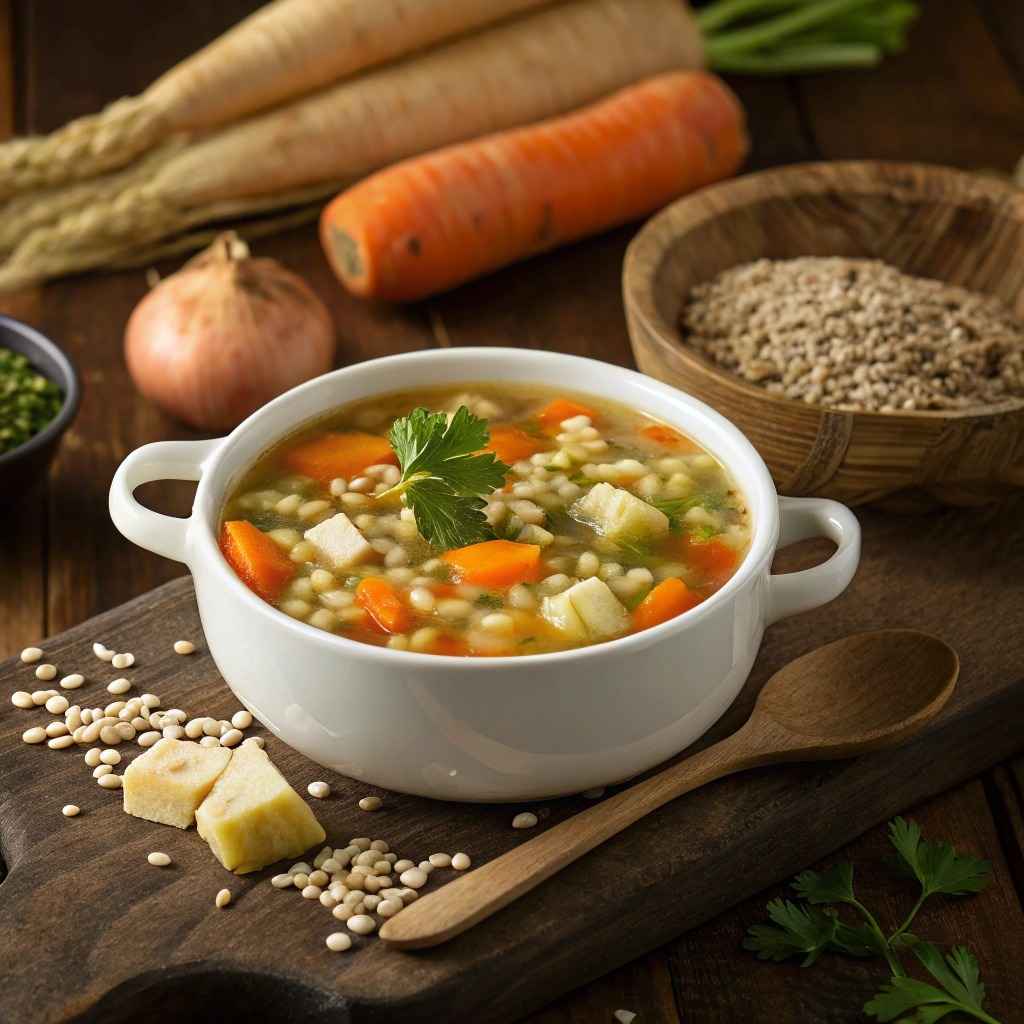
Ingredients:
- 1 cup pearl barley
- 2 carrots, diced
- 2 parsnips, diced
- 1 turnip, diced
- 1 leek, sliced (white and light green parts)
- 3 cloves garlic, minced
- 6 cups low-sodium vegetable broth
- 1 bay leaf
- 1 tsp dried thyme
- 2 tbsp olive oil
- 1/4 cup fresh parsley
- Salt and pepper to taste
Instructions:
- Heat olive oil in large pot; sauté leeks and garlic until fragrant
- Add root vegetables and cook 5 minutes
- Stir in barley, broth, bay leaf, and thyme
- Simmer 45-60 minutes until barley is tender
- Remove bay leaf, season with salt and pepper
- Garnish with fresh parsley before serving
Nutritional Benefits: Each serving provides 12g plant-based protein, 10g fiber, and significant amounts of potassium, vitamin A, and folate. The beta-glucan in barley helps lower cholesterol while providing sustained energy.
3. Healthy Viking-Style Pickled Vegetables
This probiotic-rich side dish honors traditional preservation methods while supporting modern gut health goals.

Ingredients:
- 2 cups red cabbage, thinly sliced
- 1 cup carrots, julienned
- 1/2 cup red onion, thinly sliced
- 1/2 cup apple cider vinegar
- 1/4 cup water
- 2 tbsp honey
- 1 tsp caraway seeds
- 1/2 tsp sea salt
- 1/4 tsp black peppercorns
Instructions:
- Combine vegetables in large jar or bowl
- Heat vinegar, water, honey, and spices until dissolved
- Pour warm brine over vegetables
- Let cool, then refrigerate 24 hours before serving
- Keeps refrigerated up to 2 weeks
Nutritional Benefits: These naturally fermented vegetables provide beneficial probiotics for gut health, plus vitamin K, vitamin C, and anti-inflammatory compounds. The lower sodium content makes them heart-healthy while maintaining traditional flavors.
4. Nordic Oat and Berry Breakfast Bowl
Start your day with this fiber-rich bowl that combines traditional oats with antioxidant-packed Nordic berries.
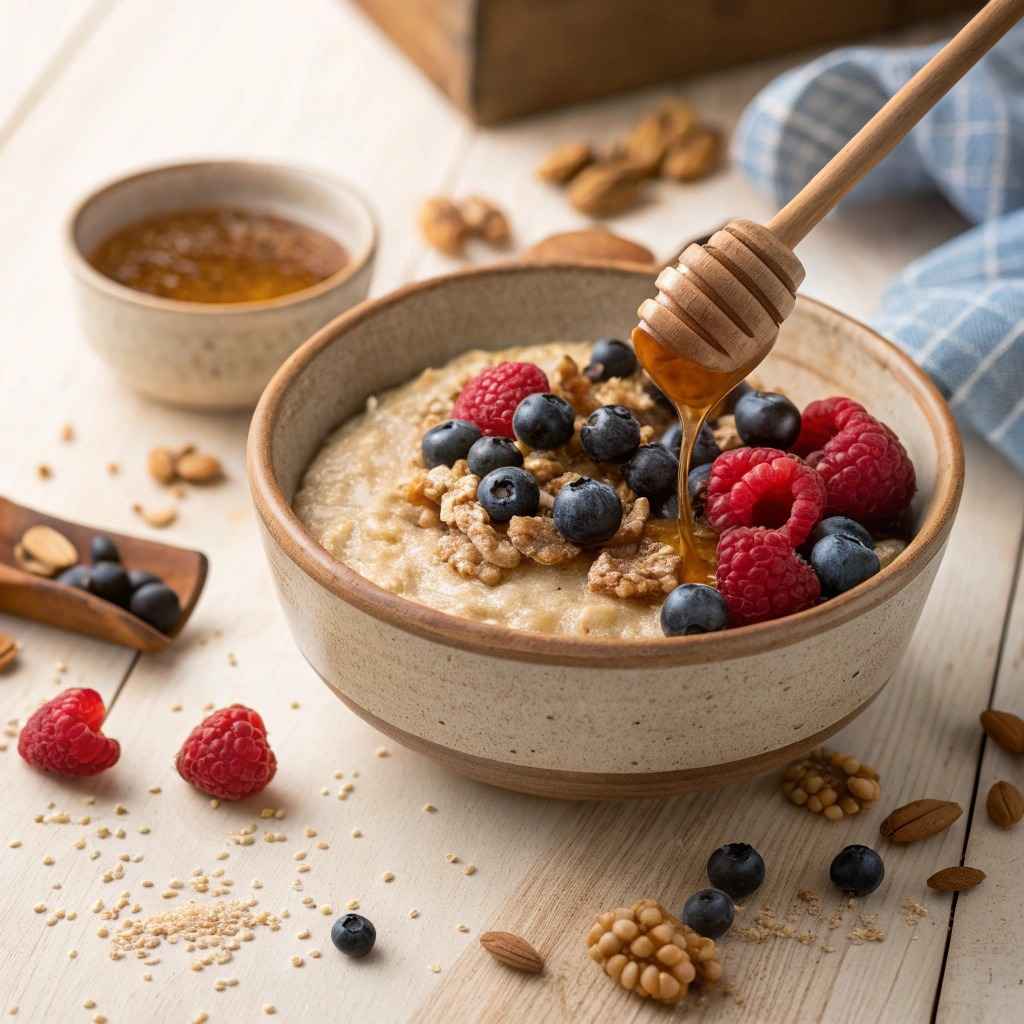
Ingredients:
- 1/2 cup steel-cut oats
- 1 cup unsweetened almond milk
- 1/2 cup mixed berries (blueberries, lingonberries, or raspberries)
- 2 tbsp chopped walnuts
- 1 tbsp ground flaxseed
- 1 tsp honey
- 1/2 tsp cinnamon
- Pinch of cardamom
Instructions:
- Cook steel-cut oats according to package directions using almond milk
- Stir in cinnamon and cardamom while warm
- Top with berries, walnuts, and flaxseed
- Drizzle with honey before serving
Nutritional Benefits: This breakfast provides 15g protein, 12g fiber, and omega-3 fatty acids from walnuts and flaxseed. The slow-digesting oats maintain steady blood sugar levels, while berries contribute antioxidants and natural sweetness.
Looking for more healthy breakfast inspiration? Try my ultimate breakfast burrito guide for protein-packed morning options.
Smart Ways to Implement Nordic Principles Today
Rather than adopting the Viking diet wholesale, focus on incorporating its healthiest elements into a balanced, modern eating pattern that suits your lifestyle and health goals.
Start with Small Changes
Harris-Pincus recommends that “anyone can include more whole foods, especially fiber-rich carbs, while limiting highly processed foods high in sugar, fat and sodium.” Begin by swapping refined grains for whole varieties like rye bread, barley, or oats, and aim to include fatty fish in your meals twice weekly.
Embrace Seasonal Eating
Follow the Viking principle of eating seasonally by choosing locally available produce when possible. This approach often provides fresher, more nutrient-dense foods while supporting environmental sustainability and often saving money.
Focus on Home Cooking
“Cooking at home with whole-food ingredients high in protein and fiber is always a good idea,” notes Harris-Pincus. This allows you to control sodium levels, choose healthy cooking methods, and avoid the excessive preservatives common in packaged foods.
Balance Macronutrients for Modern Life
While Vikings needed high-calorie, high-fat diets for survival, modern lifestyles typically require more moderate approaches. Aim for balanced meals that include lean protein, complex carbohydrates, healthy fats, and plenty of vegetables.
For comprehensive meal planning strategies that incorporate these principles, explore my collection of safe, effective weight loss drinks that complement a whole foods approach to nutrition.
The Bottom Line on Viking Diet Trends
The Viking diet offers valuable lessons about the benefits of whole foods, seasonal eating, and minimal processing. However, as with any historical eating pattern, blind adherence isn’t practical or healthy for modern life. The key lies in extracting the nutritional wisdom while adapting it for contemporary health goals and lifestyles.
Instead of viewing the Viking diet as another restrictive trend to follow perfectly, consider it a source of inspiration for building a more wholesome, sustainable approach to eating. Focus on increasing your intake of wild-caught fish, whole grains, and vegetables while cooking more meals at home using simple, quality ingredients.
Remember: the best diet is one that provides adequate nutrition, supports your health goals, fits your lifestyle, and brings you satisfaction. The Vikings were remarkable navigators and survivors, but modern nutrition science has given us tools they never had to optimize our health.
Ready to set sail on your own healthy eating journey? Start with one of the Nordic-inspired recipes above and gradually incorporate more whole foods into your daily routine. Your body – and your taste buds – will thank you for choosing sustainable nutrition over dietary extremes.
Print
Modern Scandinavian Salmon Bowl with Rye Berries
A nutrient-dense bowl combining omega-3 rich salmon with fiber-packed rye berries and seasonal vegetables for a complete, satisfying meal.
- Total Time: 20 minutes
- Yield: 2 servings 1x
Ingredients
- 1 cup cooked rye berries (or barley)
- 6 oz wild-caught salmon fillet
- 2 cups mixed greens
- 1/2 cucumber, diced
- 1/4 red cabbage, thinly sliced
- 1/4 cup pickled beets (low-sodium)
- 2 tbsp fresh dill
- 1 tbsp olive oil
- 1 tbsp apple cider vinegar
- 1 tsp Dijon mustard
- 1/2 tsp caraway seeds
- Black pepper to taste
Instructions
- Season salmon with dill, caraway seeds, and black pepper; pan-sear until cooked through.
- Whisk together olive oil, vinegar, and mustard for dressing.
- Layer greens, rye berries, cucumber, and cabbage in a bowl.
- Top with flaked salmon and pickled beets.
- Drizzle with dressing and garnish with fresh dill.
Notes
This bowl provides 35g complete protein, 8g fiber, and over 1,500mg omega-3 fatty acids.
- Prep Time: 10 minutes
- Cook Time: 10 minutes
- Category: Main Course
- Method: Pan-Searing
- Cuisine: Scandinavian
- Diet: Gluten-Free, High-Protein
Nutrition
- Serving Size: 1 serving
- Calories: 600
- Sugar: 5g
- Sodium: 300mg
- Fat: 35g
- Saturated Fat: 6g
- Unsaturated Fat: 24g
- Trans Fat: 0g
- Carbohydrates: 45g
- Fiber: 8g
- Protein: 35g
- Cholesterol: 85mg
Keywords: salmon, rye berries, healthy eating, Scandinavian recipes
